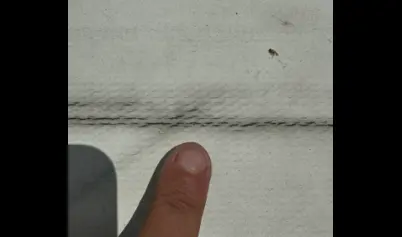ahi
TPO (thermoplastic olefin) roofs have gained a stellar reputation for their efficiency, cost-effectiveness, and durability. However, no roofing system is immune to wear and tear. Recognizing common anomalies early can make the difference between extending your TPO flat roof’s life expectancy and facing costly repairs or replacements.
In this post, we’ll dive into the seven most common issues TPO roofs face, why they occur, and how to proactively address them. Whether you’re a property manager, facility director, or building owner, this guide will arm you with the knowledge you need to protect your investment.
1. Cold Welds: The Hidden Threat to Your TPO Roof’s Integrity
A cold weld happens when the seams of your TPO membrane fail to bond correctly during installation. These weak points can allow water to seep through, leading to costly interior damage.
Why It Happens:
- Improper heat application during welding.
- Poor weather conditions during installation.
Pro Tip:
- Partner with a trusted roofing contractor to ensure proper installation. Regular inspections can also catch cold welds early before they become a major problem.

2. Punctures: Small Tears, Big Problems
TPO flat roofs are highly resistant to damage, but punctures can still occur, especially in high-traffic areas. Foot traffic, fallen debris, or sharp objects can all compromise your roof’s protective layer.
Why It Happens:
- Heavy equipment or tools dropped on the roof.
- Improperly managed rooftop activities.
- Blown debris on the roof.
Pro Tip:
- Limit foot traffic on your roof by designating walkways or installing protective mats. Encourage your maintenance team to be cautious when handling tools and equipment.

3. Storm Damage: Nature’s Impact on Your TPO Roof
From hail to high winds, severe weather events can wreak havoc on a TPO roof. Storm damage often leads to punctures, membrane tears, or loosened seams, which can reduce the roof’s lifespan significantly.
Signs of Storm Damage:
- Missing sections of the membrane.
- Visible tears or punctures.
- Pooling water after heavy rainfall.
Pro Tip:
- Schedule a professional inspection after major storms to catch issues early.

4. Ponding Water: The Silent Roof Killer
Flat roofs are particularly prone to ponding water, and TPO roofs are no exception. Ponding water accelerates membrane degradation, especially in areas with poor drainage.
Why It’s Dangerous:
- Prolonged exposure to water can weaken the TPO material.
- Creates ideal conditions for algae or mold growth.
Pro Tip:
- Ensure your roof’s drainage system is in top condition. Regularly clear debris from drains and consider adding tapered insulation to redirect water.

5. Wrinkling and Bridging on Parapet Walls
Wrinkling or bridging occurs when the TPO membrane separates or pulls away from parapet walls, often due to shifting or adhesive failure.
What Causes It:
- Structural movement in the building.
- Poor adhesion during installation.
Pro Tip:
- Conduct annual inspections to identify early signs of wrinkling. Address issues immediately to prevent further damage.

6. Penetrations and Seams: The Weakest Links
Penetrations and seams are the most common points of failure on TPO roofs. These areas are exposed to constant stress, making them prone to leaks.
What to Watch For:
- Cracking or separation at seams.
- Water stains near rooftop penetrations.
Pro Tip:
- Invest in professional-grade seam reinforcement and inspect these areas quarterly for signs of wear.

7. Deteriorated Sealant in Pitch Pockets
Pitch pockets protect penetrations like pipes or conduits, but over time, the sealant within them can deteriorate, leaving your roof vulnerable.
Signs of Deterioration:
- Cracking or peeling sealant.
- Water pooling around pitch pockets.
Pro Tip:
- Reapply sealant as part of your regular roof maintenance schedule to keep water out.

Tips to Extend the Life Expectancy of Your TPO Roof
While these anomalies may seem daunting, proactive maintenance can significantly increase your TPO flat roof’s life expectancy. Here’s how:
- Reduce Foot Traffic: Install walk pads and limit access to only essential personnel.
- Schedule Regular Inspections: A professional inspection twice a year can identify potential problems early.
- Address Drainage Issues Immediately: Water is your TPO roof’s worst enemy. Ensure drains are clear and functioning.
- Work with Experienced Contractors: Whether it’s installation, repair, or maintenance, trust a qualified roofing professional to handle your TPO roof.
Don’t Wait Until It’s Too Late—Call the Experts
Protecting your TPO flat roof from common anomalies starts with regular maintenance and inspections. At Commercial Roof Repair Solutions, we specialize in identifying and addressing these issues before they lead to costly damage.
📞 Call us today at 281-928-4428 to schedule your TPO roof inspection or repair. Serving Houston, TX, and the surrounding cities like Pasadena, Baytown, Sugar Land, and Pearland, we’re here to keep your roof in top condition.
By staying proactive, you can ensure your TPO roof achieves its maximum life expectancy while keeping your building safe and energy-efficient. Don’t let small issues turn into big problems—act now!
Table of Contents
READ MORE!

